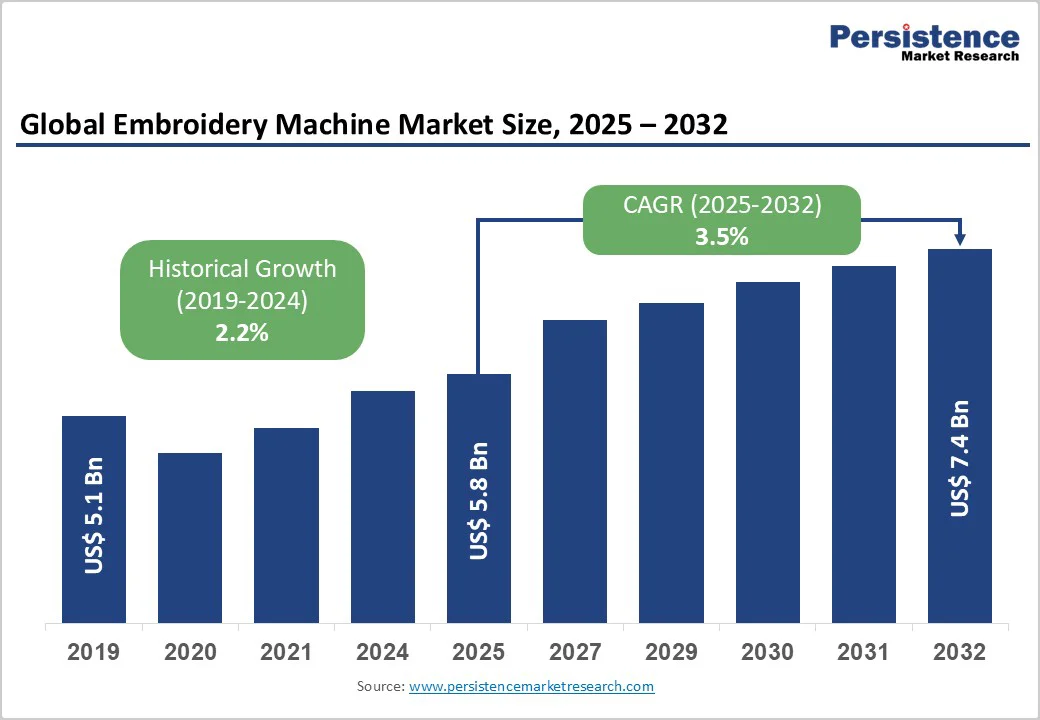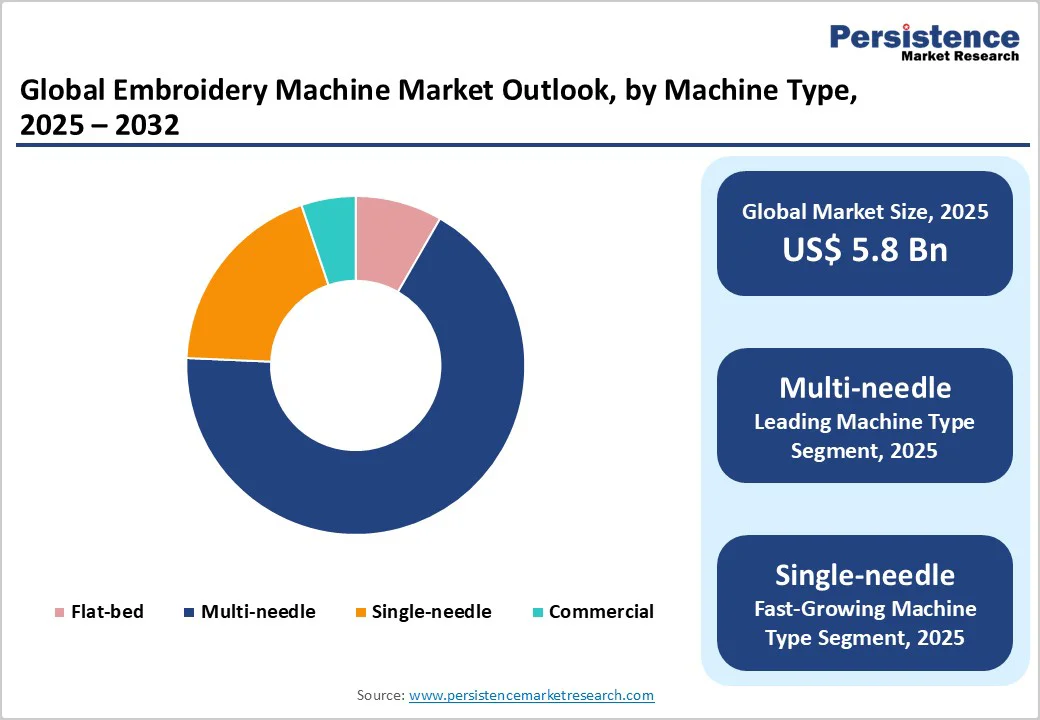ID: PMRREP35839| 188 Pages | 11 Nov 2025 | Format: PDF, Excel, PPT* | Industrial Automation

The global embroidery machine market is expected to reach US$5.8 billion in 2025. It is estimated to reach US$7.4 billion in 2032, growing at a CAGR of 3.5% during the forecast period 2025 - 2032, driven by the rising demand for personalized products and supportive government initiatives. Automation, multi-needle systems, and AI-assisted features are also enabling firms to work with high precision.
| Key Insights | Details |
|---|---|
| Embroidery Machine Market Size (2025E) | US$5.8 Bn |
| Market Value Forecast (2032F) | US$7.4 Bn |
| Projected Growth (CAGR 2025 to 2032) | 3.5% |
| Historical Market Growth (CAGR 2019 to 2024) | 2.2% |

Government-backed production-linked incentive programs in India and Vietnam are supporting the adoption of embroidery machines in technical-textile manufacturing. These schemes provide financial subsidies and tax benefits to manufacturers who invest in automated machinery, mainly for high-value textile lines. This allows companies to upgrade to multi-head and computerized embroidery machines without bearing the full cost.
For instance, India’s textile hubs such as Tiruppur and Surat are now integrating novel embroidery machines to produce uniforms, home textiles, and industrial fabrics. This initiative modernizes the manufacturing base and also strengthens export capabilities, positioning Asia Pacific as a global leader in both decorative and functional textile applications.
The rising popularity of on-demand custom clothing among North America’s direct-to-consumer (DTC) brands is pushing demand for embroidery machines. Consumers seek personalized apparel featuring logos, monograms, or unique designs, prompting brands to invest in high-precision, digital embroidery systems. Companies such as Brother and Janome are supplying machines with wireless design transfers and multi-needle capabilities to meet this demand efficiently.
For example, DTC brands producing limited-edition streetwear or corporate merchandise can now expand production while maintaining intricate detailing, which was previously labor-intensive. This trend is transforming the market, as small businesses and home-based enterprises adopt compact, computerized machines to quickly deliver bespoke products.
The steep investment required for multi-head embroidery machines, often exceeding US$50,000, is a key barrier for small and medium-sized enterprises (SMEs) in South America. Several local apparel decorators and textile workshops lack the financial capacity to purchase or maintain this high-end equipment, restricting their ability to expand operations or adopt automated systems.
This challenge has led small-scale players to continue relying on single-needle or semi-automatic machines, which are less efficient and limit production capacity. For example, emerging clothing brands in Brazil and Colombia often struggle to justify investing in new multi-head lines despite rising demand for complex designs.
Europe faces a talent shortage in the embroidery segment due to an aging pool of experienced operators, which is constraining machine utilization rates. Today’s computerized embroidery machines require skilled handling to maintain efficiency and avoid production errors, yet fewer trained technicians are available to manage them.
In Germany, Italy, and Switzerland, textile workshops are reporting that multi-needle and industrial machines are underutilized because operators lack training in modern digital embroidery software or in novel machine features. This skills gap limits the full potential of automation, slowing productivity and discouraging new investments.
Multi-needle embroidery machines are expected to account for approximately 67.4% of the share in 2025, as they help boost productivity and efficiency in industrial settings. They allow multiple thread colors to be used simultaneously without manual changes, which is ideal for large-scale apparel, promotional products, and home textile manufacturing.
For example, Tajima’s multi-head machines in North America and Asia Pacific can complete complex designs with multiple colors in a fraction of the time, making them suitable for mass production and commercial embroidery businesses.
Single-needle machines are predicted to expand at a CAGR of nearly 8.9% through 2032. This is owing to their affordability, simplicity, and suitability for small-scale operations or home use. They are popular among hobbyists, small businesses, and custom embroidery shops, where precision and detailed designs matter more than speed.
Machines such as Brother’s SE600 and Janome’s Magnolia 7330 provide user-friendly interfaces and reliable performance. These allow users to experiment with personalized designs and limited production runs without the complexity of multi-needle machines.
Computerized embroidery machines are estimated to hold nearly 66.2% of the share in 2025, as they combine precision, speed, and versatility, allowing users to execute complex designs with minimal errors. Features such as automated thread cutting, stitch regulation, and pre-programmed patterns reduce manual intervention, saving time and labor. For instance, Brother’s Stellaire2 Innov-ís XE2 integrates with wireless design transfer and AI-assisted stitching, enabling professionals and hobbyists to achieve intricate designs efficiently.
Digital embroidery machines are experiencing strong demand due to their seamless integration with design software and connectivity options, enabling greater customization and faster production of personalized products. Machines such as Janome’s Continental M17 and Bernina B 790 PLUS enable users to import digital patterns, extend designs, and make real-time adjustments, catering to small businesses, e-commerce sellers, and promotional product manufacturers.
The textile industry is expected to hold a share of around 61.8% in 2025, as it requires large-scale production of decorative patterns, logos, and functional stitching on garments, home textiles, and industrial fabrics. Multi-head and computerized machines enable manufacturers to maintain consistency and speed while handling complex designs. For example, China and India rely heavily on industrial embroidery machines to produce uniforms, bed linens, and upholstery with intricate patterns.
The fashion industry is projected to record a CAGR of approximately 10.1% in the foreseeable future, as designers and brands demand high precision, customization, and intricate detailing to improve garment aesthetics. Bernina’s B 790 PLUS and Brother Stellaire2 Innov-ís XE2 allow designers to create elaborate motifs, monograms, and seasonal collections efficiently. The rise of personalized fashion and limited-edition apparel has further increased the reliance on digital embroidery machines.

Asia Pacific will likely account for a share of approximately 47.3% in 2025, owing to its well-established textile manufacturing base and increasing adoption of automation technologies. The industrial segment dominates the market, holding a substantial share due to high productivity demands in the apparel and home textile sectors.
Multi-head embroidery machines are mainly favored for their efficiency in mass production. The rise of e-commerce platforms has spurred the demand for home-use embroidery machines, catering to small businesses and hobbyists.
Technological developments are central to the region's growth, with manufacturers integrating AI and IoT into computerized sewing and embroidery machines. This trend is supported by government initiatives promoting automation and smart manufacturing. Countries such as India are experiencing exponential growth in industrial embroidery machine adoption, propelled by rising demand for personalized products and promotional goods.
North America’s market is being influenced by the ongoing adoption of automation and a surging demand for personalized products. The region is witnessing a steady shift toward high-tech and user-friendly machines that cater to both industrial and home-use applications. In the industrial sector, companies such as Tajima America and Barudan are leading the way with innovations, including automatic thread tension adjustment and servo motor-driven multi-head machines.
They are hence improving efficiency and precision in mass production. These developments are specifically beneficial for applications in apparel and promotional merchandise. On the consumer front, brands such as Brother and Janome are introducing novel home-use embroidery machines equipped with features, including wireless connectivity and large embroidery areas, appealing to hobbyists and small businesses. This trend complies with the surging interest in DIY projects and personalized fashion items.
Europe’s market is characterized by a blend of traditional craftsmanship and technological development, with Germany at the forefront. Companies such as ZSK Stickmaschinen GmbH, based in Krefeld and Remscheid, are renowned for their high-quality industrial embroidery machines, including single-head and multi-head models. These are designed for various applications, from fashion to technical textiles.
ZSK emphasizes sustainability, with over 80% of components sourced from regional suppliers and production facilities powered mainly by solar energy. Other notable domestic manufacturers include Bernina International AG, headquartered in Switzerland, which produces a range of household and industrial embroidery machines, and Frister & Rossmann, a firm based in Germany, with a long history in sewing and embroidery systems. These companies contribute to Europe's reputation for precision engineering and development in the embroidery machine business.

The global embroidery machine market is moderately concentrated, with leading players holding significant shares. In 2024, Asia Pacific dominated the global market, accounting for over 40% of global revenue, driven by large-scale textile manufacturing in China, Japan, and India.
The market is a mix of established global brands and regional manufacturers. Companies such as Brother Industries, Tajima, and Bernina lead in development and market presence. Regional players, including Feiya, Yuelong, and Zhejiang Lejia, are gaining traction, especially in the emerging markets.
The embroidery machine market is projected to reach US$5.8 Billion in 2025.
Rising demand for personalized apparel and the growth of home-use machines are the key market drivers.
The embroidery machine market is poised to witness a CAGR of 3.5% from 2025 to 2032.
Increasing adoption of smart machines and e-commerce-driven custom embroidery are the key market opportunities.
Viking, Hasenfratz, and Bernina are a few key market players.
| Report Attribute | Details |
|---|---|
| Historical Data/Actuals | 2019 - 2024 |
| Forecast Period | 2025 - 2032 |
| Market Analysis | Value: US$ Bn |
| Geographical Coverage |
|
| Segmental Coverage |
|
| Competitive Analysis |
|
| Report Highlights |
|
By Machine Type
By Technology
By Application
By Region
Delivery Timelines
For more information on this report and its delivery timelines please get in touch with our sales team.
About Author